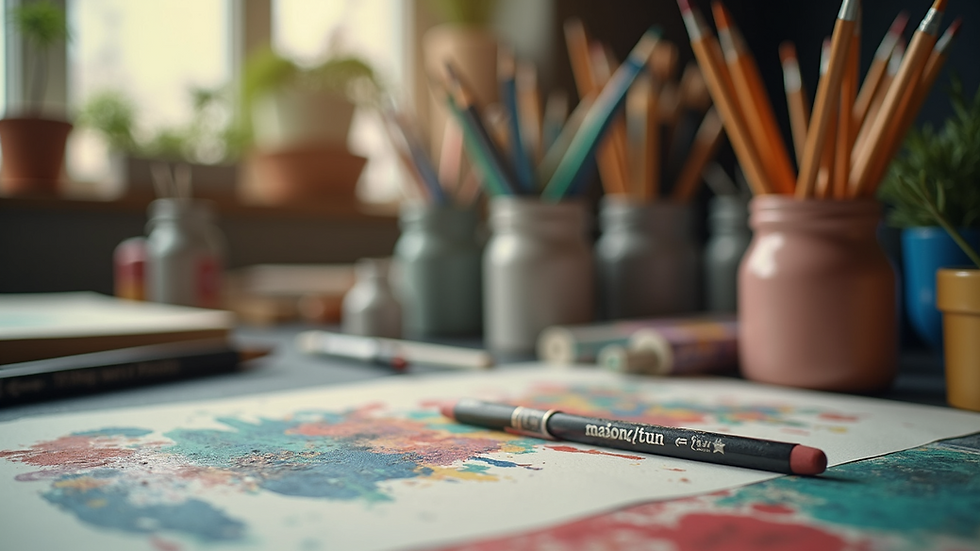Showcase Your Talent with a Multimedia Artist Portfolio
- Lindsey Maldonado
- Jul 7
- 4 min read
In today's digital age, showcasing your skills as a multimedia artist is crucial for standing out in a competitive market. An artist portfolio is not just a collection of your work; it is a presentation of your unique style, creativity, and technical abilities. It allows potential clients or employers to understand your capabilities at a glance. An engaging portfolio can give you the edge you need to upsell your services and build a following.
Artist Portfolio Ideas
Creating an effective artist portfolio involves thoughtful organization and curated content. Here are some key ideas for multimedia artists looking to up their portfolio game.
1. Curate Your Best Work
Start by selecting your best pieces. Quality always trumps quantity. Focus on pieces that showcase your diverse skills and artistic range. Whether it’s digital art, illustrations, or animations, ensure that each work exemplifies your unique style.
Consider including at least five to ten pieces that resonate with your artistic vision. It might be worth researching current trends in multimedia art. Websites like Behance or Instagram can provide inspiration and help you identify popular styles. Additionally, don’t hesitate to remove older works that no longer reflect your current abilities.

2. Say Something with Your Work
Your portfolio should tell a story about who you are as a multimedia artist. This narrative can help potential clients connect with you on a personal level. Each piece should be accompanied by a brief description that explains the concept behind it, the techniques you used, and the inspiration you drew from.
Including behind-the-scenes insights, such as sketches or process photos, can also enrich the storytelling. For example, if you designed an illustration for a client, share how that collaboration influenced the final piece. This adds depth and context to your work.
3. Show Versatility
As a multimedia artist, showcasing versatility can enhance your appeal. Clients often look for artists who can adapt their styles to various projects. Include a mix of different media types—illustrations, video snippets, and graphic designs—to prove that you can handle various tasks effectively.
Consider segmenting your portfolio into sections based on style or medium. For example, one section could be entirely dedicated to photography, while another could focus on animation. This clear organization makes it easier for viewers to navigate through your work.

4. Optimize for Web
In today’s fast-paced world, having an online portfolio is essential. Build a website that hosts your multimedia artist portfolio. Platforms like Squarespace, Wix, or WordPress offer user-friendly templates designed specifically for artists.
Ensure that your website is mobile-friendly. Many people will view your portfolio on their phones, and a mobile-optimized site can enhance user experience. Additionally, speed is critical; a slow-loading site can deter viewers from exploring your work.
Incorporating SEO tactics can increase your portfolio's visibility. Use keywords that relate to your work and include meta descriptions for each page. If you specialize in a certain niche, make sure your website reflects that.
5. Foster Engagement
Engagement is crucial in this digital era. Including an “About Me” section can personalize your portfolio, giving viewers insight into your journey as an artist. Share your techniques, education, or any relevant experiences that shaped your artistic path.
Consider integrating social media channels to allow your audience to connect with you more profoundly. Linking your Instagram or LinkedIn can keep your portfolio dynamic, showcasing your latest projects and inspirations.
Encourage feedback by adding a contact form where visitors can reach out. Establishing connections with your audience can lead to potential collaborations or commissions.

Share Your Journey
Lastly, don’t underestimate the power of sharing your journey. Use your platform to document your artistic process, the challenges you face, and your successes. These insights can help demystify the creative process for your audience and create deeper connections. Utilize social media not just to showcase completed works but also to engage your audience in your artistic journey.
Incorporating a blog or video section on your portfolio site can further enhance this ongoing conversation. People appreciate a more personal approach; sharing your ups and downs will make you a more relatable artist.
By keeping these suggestions in mind, you can create a multimedia artist portfolio that effectively showcases your talent and engages your audience. Whether you’re starting out or looking to revamp an existing portfolio, a well-structured presentation will help propel your artistic career forward.
Taking the Next Steps
Now that you’re aware of the elements required for a captivating multimedia artist portfolio, it’s time to take action. Start by evaluating your current portfolio. Are the pieces reflective of who you are as an artist?
Consider reaching out to peers or mentors for feedback. Their insights could lead you to make necessary adjustments that might go overlooked.
Exploring established portfolios online can also inspire your revisions. Identify elements you admire and incorporate them into your presentation.
Remember, a multimedia artist portfolio is not just a collection of your artwork—it’s a glimpse into your creative world. Embrace the process and take the necessary steps to showcase your talent effectively.
In this digital age, showcasing your artistic journey online is not just an option, but a necessity. Embrace the opportunity to create a portfolio that stands out and speaks to your capabilities as a multimedia artist. Let your work shine, and watch as it captivates your audience!




Comments